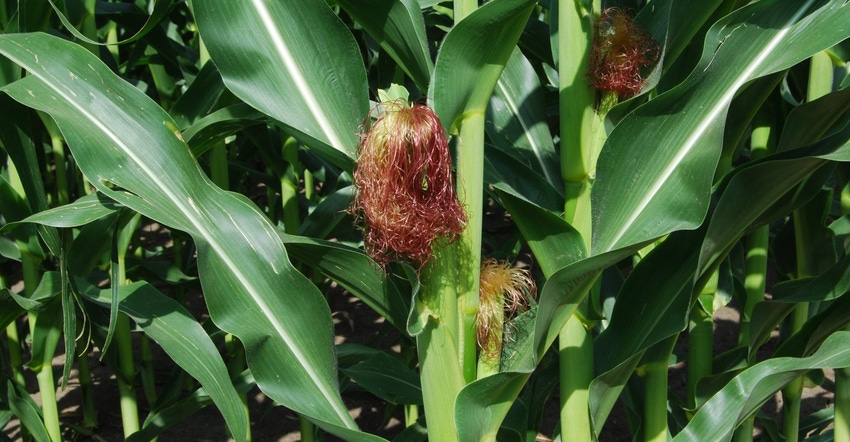
Warmer and drier weather last week was welcomed by Butch Teske, farming in Audubon County in western Iowa. He could get into his fields to spray for weeds, as the soil finally dried out. Topsoil moisture in his crop reporting district is 84% adequate and 16% surplus, according to USDA’s weekly survey as of July 8. Subsoil moisture has the same rating. “We don’t have any real dry areas in this part of the state,” he notes.
However, southeast and south-central Iowa could use some rain, as of July 9. Those areas are the driest in Iowa this summer.
Flooded fields draining
“Much of the state saw drier conditions last week that allowed saturated fields to start draining and gave farmers the opportunity to do some spraying and other work that had been delayed by the wet weather,” notes Iowa Secretary of Agriculture Mike Naig. “In general, Iowa’s crops are maturing quickly, with both corn and soybean development more than a week ahead of the five-year average.”
The complete weekly Iowa Crop Progress and Weather Report is available on the Iowa Department of Ag and Land Stewardship at iowaagriculture.gov or on USDA’s site, nass.usda.gov/ia. The report summary follows.
Crop report
Warm weather and drier conditions allowed Iowa farmers 4.8 days suitable for fieldwork during the week ending July 8, according to USDA’s National Ag Statistics Service. Activities for the week included, herbicide and fungicide application, detasseling seed corn and harvesting hay.
Topsoil moisture rated 2% very short, 9% short, 72% adequate and 17% surplus. Subsoil moisture rated 4% very short, 10% short, 69% adequate and 17% surplus. Some fields remain ponded and have struggled to drain in the more saturated northern two-thirds of the state. In south central and southeast Iowa topsoil moisture supplies remain one-third to one-half short to very short.
Corn running 8 days ahead
Statewide, 35% of the corn crop has silked, eight days ahead of both last year and the five-year average. And 78% of the corn crop is rated in good-to-excellent condition. The survey shows 46% of the soybean crop is blooming, over one week ahead of the average. Also, 7% of the state’s soybean crop was setting pods as of July 8, which is three days ahead of last year and six days ahead of the average. Iowa’s soybean crop is 76% in good-to-excellent condition.
The 2018 Iowa oat crop is 97% headed with 51% turning color, two days ahead of the average. The oat crop is rated 78% in good-to-excellent condition. Second cutting of alfalfa hay reached 49% complete, six days ahead of average. Drier conditions provided producers a window to put up more hay. Hay condition declined to 71% good-to-excellent. Pasture conditions also declined slightly to 64% good-to-excellent. Heat and high humidity have been hard on livestock, but cool overnight temperatures have helped reduce stress.
Weather summary
According to Justin Glisan, IDALS climatologist, the Fourth of July holiday week was relatively calm compared to the previous few weeks. Much of Iowa was able to dry out from the previous week’s widespread thunderstorm activity.
For the week ending July 8, a majority of the state saw below normal rain accumulation, from a few tenths to a little over an inch.
On the other hand, Iowa’s northwest corner saw more rainfall, generally on the order of one to two inches above normal. On June 2, only a handful of reporting stations from Plymouth to Kossuth Counties recorded measurable rainfall, with Swea City observing 0.89 inch.
The state was dry heading into Independence Day, though a cold front propagated through Iowa’s northern third during the afternoon of July 4. The full system moved through overnight into July 5, bringing near normal temperatures and lower humidity. Pocahontas recorded 2.90 inches of rain from the frontal passage, which was the week’s highest rainfall accumulation, and 2.74 inches above normal. There were also multiple reports of severe straight-line winds from Shelby County in the southwest to Winnebago County in northern Iowa, with a 61-mph gust in Lake Mills.
Northwest Iowa gets more rain
July 5-8 saw nearly dry and sunny conditions reigning over the state. This pattern was attributed to a large high-pressure system moving through Minnesota into the Great Lakes region. On June 6, a few counties in southeast and northwest Iowa observed measurable rain from isolated thunderstorms. The town of Washta in Cherokee County reported 1.50 inches.
Over the weekend, average highs ranged from the low-to-mid 80s across the north and mid-to-upper 80s in the south. The week’s high temperature was 97 degrees and was observed in De Soto on July 4 and Lamoni on July 5. Sheldon, in O’Brien County, reported the week’s low temperature of 49 degrees on July 7. This reading was 10 degrees below average.
About the Author(s)
You May Also Like




